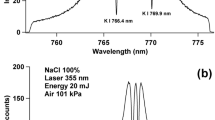Abstract
Space and time-resolved studies of laser induced plasmas in air at atmospheric pressure are presented. Photovoltaic solar cells have been used as samples. The second harmonic (532 nm) of a Nd: YAG laser at an irradiance of 18 × 1012 W/cm2 has been used. The precise focus of the beam allows a microanalysis at a 0.02 mm2 surface area working in single-shot mode. The use of an intensified charge-coupled device (CCD) detector has allowed time-resolved studies in both imaging or spectroscopy modes. The two-dimensional capability of the CCD has enabled the study of atomic and ionic species distribution along the plume. Most data have been recorded using single-laser shot experiments. Spectral lines have been assigned to transitions in atomic components of the material under investigation in the neutral or ionic states of the corresponding atoms. Effects of delay in improving spectral resolution and some examples of spectral characterization of species as a function of its decay are shown.
Similar content being viewed by others
References
Cremers DA, Radziemsky LJ, Loree TR (1984) Appl Spectrosc 38: 721
Cabalín LM, Calvo N, Ayala L, Laserna JJ (1992) Quim Anal 12: 96
Morris JB, Forch BE, Miziolek AW (1990) Appl Spectrosc 44: 1040
Wachter JR, Cremers DA (1987) Appl Spectrosc 41: 1042
Ng KC, Ayala NL, Simeonsson JB, Winefordner JD (1992) Anal Chim Acta 269: 123
Ottesen DK (1992) Appl Spectrosc 46: 593
Lorenzen CJ, Carlhoff C, Hahn U, Jogwich M (1992) J Anal Atom Spectrom 7: 1029
Ottesen DK, Wang JCF, Radziemsky LJ (1989) Appl Spectrosc 46: 967
Laserna JJ, Calvo N, Cabalín LM (1993) Anal Chim Acta 289: 113
Lee YI, Thiem TL, Kim GH, Teng YY, Sneddon J (1992) Appl Spectrosc 46: 1597
Thiem TL, Salter RH, Gardner JA, Lee YI, Sneddon J (1994) Appl Spectrosc 48: 58
Dittrich K, Mohamad I, Hguyen HT, Niebergall K, Pfeifer M, Weinrich R (1990) Fresenius J Anal Chem 337: 546
Sneddon J, Mitchell PG, Nogar NS (1989) In: Radziemsky LJ, Cremers DA (eds) Laser-induced plasmas and applications, Chap 9. Dekker, New York
Moenke-Blankenburg L (1993) In: Vertes A, Gijbels R, Adams F (eds) Laser ionization mass analysis, Chap 4B. Wiley, New York
Montes R (1994) In: Laserna JJ, Pérez Bendito L (eds) Temas avanzados de análisis químico, Chap 3. Edinford, Málaga
Weyl GM (1989) In: Radziemski LJ, Cremers DA (eds) Laserinduced plasmas and applications, Chap 1. Dekker, New York
Kim YW (1989) In: Radziemski LJ, Cremers DA (eds) Laserinduced plasmas and applications, Chap 8. Dekker, New York
Reader J, Corliss CH, Wiese WL, Martin GA (1980) In: Wavelengths and transition probabilities for atoms and atomic ions. NSRDS-NBS 68. US Government Printing Office, Washington, DC
Author information
Authors and Affiliations
Rights and permissions
About this article
Cite this article
Vadillo, J.M., Milán, M. & Laserna, J.J. Space and time-resolved laser-induced breakdown spectroscopy using charge-coupled device detection. Fresenius J Anal Chem 355, 10–15 (1996). https://doi.org/10.1007/s0021663550010
Received:
Revised:
Accepted:
Issue Date:
DOI: https://doi.org/10.1007/s0021663550010




